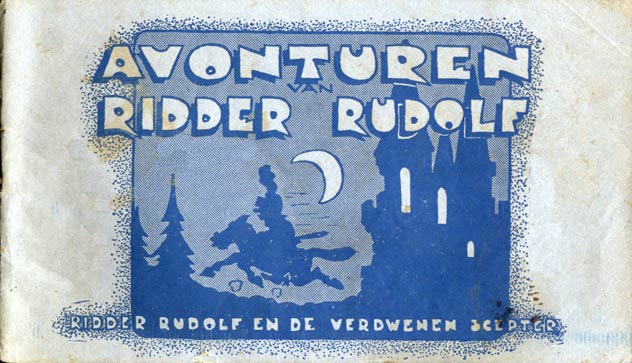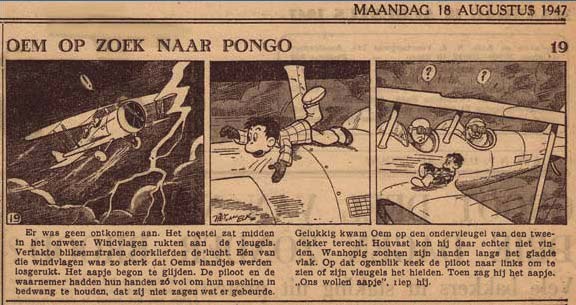'Avonturen van Bim. Het Verdwenen Land Lemurië'.
Piet van Elk (known in the USA as Peter van Elk) was a Dutch comic artist and animator, whose career spanned from the 1940s until the early 1980s. In his home country he is best known for creating the newspaper comic strip 'De avonturen van Bim' (1942-1951) with his brother John and later with Eddie Bayer. He was the initiator of Stripfilm (1945), the first Dutch independent comic magazine. He additionally created newspaper comics like 'Berry en Terry' (1945), 'Dokie Durf' (1945-1950) and 'De Avonturen van Oem' (1945-1947), after which he focused on a career in the animation industry. He eventually settled in the USA, where he worked as a background painter for Hanna-Barbera cartoons from 1964 to 1982.
Pre-war drawings by Piet van Elk. "Bim Brom" appears to be a predecessor of his later character Bim.
Early life and career
Piet Van Elk was born in Amsterdam in 1919, and got his artistic education at the local Kunstnijverheidschool from 1937 to 1941. Before the war, Van Elk played the saxophone and clarinet in the Dixieland band The Jam Fans, which also featured Siem Praamsma on trumpet. Both Van Elk and Praamsma had a fascination for animation, and when Van Elk acquired a few feet of animated film from Max Fleischer's 'Popeye The Sailorman', the two men carefully studied and analyzed it.
'Avonturen van Ridder Rudolf'. 'Ridder Rudolf en de Verdwenen Scepter'.
Animation career
Piet and his brother John van Elk (21 February 1921- September 1944) had the ambition to create short animated films themselves, inspired by the success of Pat Sullivan's 'Felix the Cat' and Walt Disney's 'Mickey Mouse'. In 1942, they opened their Amsterdam-based studio and started working on a film starring the character 'Bim'. However, the bad conditions during the war cut the project short after the creation of only two-and-a-half minutes of film.
'De Avonturen van Drie Musketiers'.
De Avonturen van Drie Musketiers
In the meantime, the Van Elk Brothers had debuted as comic authors with two self-published books, drawn by Piet and written by John. 'De Avonturen van Drie Musketiers' ('The Adventures of the Three Musketeers') appeared in the summer of 1942, and was followed by the shadow play comic 'De Avonturen van Ridder Rudolf' in the autumn of that year. According to Siem Praamsma, Van Elk had also offered newspaper De Telegraaf to continue the 'Mickey Mouse' strip after its ban in June 1941. But even the Nazi supervisor didn't dare to breach Walt Disney's copyright.
Bim
Piet and John van Elk made three booklets with 'Bim': 'Bim en de Treinrovers' (presumably 1942), 'Bim en De Brug over de Oceaan' (1943) and 'Bim en de Ballontocht Naar de Middeleeuwen' (1943). 'Bim en de Treinrovers' presented 'Bim' as a little kitten. In the second book, they changed the main character into a little boy, to avoid the resemblance with Marten Toonder's 'Tom Poes', who had started his adventures in De Telegraaf in 1941.
Bim, then still a kitten, in 'Bim en de Treinrovers'.
Stripfilm
During World War II, the Van Elk brothers earned their money as interior decorators, and used their income to finance their artistic projects. The letterhead on their stationary from 1943 already shows the name "Stripfilm", and presented the studio as a publisher of picture stories, illustrations, advertisements and animated films. The correspondence address for "P.J. van Elk" was Titiaanstraat 29 in the south of Amsterdam.
Bim, now a boy, in 'Bim en de Ballontocht naar de Middeleeuwen'.
By 1943, John van Elk rented a room with the Milo family at the Parnassusweg 26 in Amsterdam, which he defiantly decorated with an image of the theme of Beethoven's 5th symphony, the short-short-short-long code for victory over Nazism. He was later caught as an underground courier on his way to the Swiss border, and sent to the Neuengamme concentration camp near Hamburg around September 1944. He died there, shortly before the end of the war. On 21 June 1945, an ad was published in the newspaper De Waarheid asking for information about his whereabouts. The Beethoven drawing remained on the wall as long as the Milo family lived in the building, recalled their son Thomas Milo on Facebook in 2017.
Letterhead of the Stripfilm studio, and Piet van Elk's newspaper add (De Waarheid, 13 July 1945).
Stripfilm magazine
Piet van Elk decided to further pursue the ambition he and his brother had after the war. A newspaper ad in De Waarheid of 13 July 1945 shows him recruiting animators and comic artists at his studio at the Singel 356 in Amsterdam. One of them was his former bandmate Siem Praamsma, who had also worked for the Toonder Studios during the war. Henk Albers and Albert van Beek, also two wartime Toonder animators, additionally joined the team. In order to provide information about all facets of the development of animated films, Van Elk founded a weekly magazine called Stripfilm. All other pages in this magazine were filled with comics. "Henry" Albers made the comics 'Jimmy Stone' and 'Chickey Walker' with writer Joop Elenbaas, while Van Beek drew the realistic feature 'Frank Duffard' and Praamsma provided 'Bullie Pats'. Van Elk drew 'Plucky Pluis' and new stories with 'Bim'. The team was completed with the inkers Henk Sprokkreef and Flip van der Schalie, and the text writers Eddie Bayer and John van Snellenberg.
Two Stripfilm covers by Henk Albers.
The first issue of Stripfilm appeared on 15 October 1945, and the fifth and final issue on 23 November of that same year. The announcement that Walt Disney's 'Mickey Mouse' would make his appearance in the magazine was never fulfilled. Although short-lived and highly obscure, Stripfilm holds historical significance for being the first self-published Dutch comic magazine, long before the arrival of underground comix and fanzines.
Cover for the never released 'Bim' picture book by Mulder & Zoon (1947)
Stripfilm newspaper comics
The Stripfilm studio continued its activities throughout the 1940s however. From 1947 on, the team was located at the Albrecht Dürerstraat 1. The studio now focused on producing comics which were distributed to regional and Belgian newspapers through the Persbelangen syndicate. Siem Praamsma created 'Jochem Jofel' and 'Ootje Teur', Albert van Beek 'Ronny en Donny' and 'Naar Zee'. The future TV producer Flip van der Schalie made two stories with 'Bollie Bof' and other newspaper comics came from the newcomers Francis Paid ('Joris Voetangel'), Willy Kuyper ('Tobias Sloom' and 'Binky') and Hans Nije ('Tim Tuimel').
'Terry en Berry', from De West, a newspaper from the Dutch colony of Suriname (31 January 1949).
John van Elk's old friend Eddie Bayer, a writer and philosopher also known as Hilarion, assumed the writing duties for Piet van Elk's newspaper comics. He enriched the 'Bim' universe with new characters like the investigator Mugli Basli and the evil Geoffrey Wicked. The duo made 28 new stories of 45 to 60 episodes each for regional newspapers like Eindhovens Dagblad until mid-1951. The publisher of the daily newspaper Gooische Klanken released two more book collections in 1947: 'Hypnose Onder Nul' and 'Het Verdwenen Land Lemurië'. In 1947, Van Elk also made a full-color picture book of the story 'Bim en De Zeerovers' for the publisher Mulder & Zoon, but for some reason, the book was never released. During the 1950s, 'Bim' appeared in reruns under the title 'Jefke' in the magazine Robs Vrienden.
'De Avonturen van Dokie Durf'. 'De Bedorven Keizer'.
Other newspaper comic creations
During the late 1940s, Van Elk and Bayer published 'Dokie Durf' in several newspapers through the Persbelangen agency in Utrecht. From August to December 1945, they made the adventures of the two bears 'Terry en Berry' for Het Parool until the strip was replaced by Pieter Kuhn's 'Kapitein Rob'. 'De Avonturen van Oem', about a little monkey, ran in Trouw from July until November 1947. Van Elk recalled the strip received heavy criticism from his Protestant editors, who deemed elements like a mascot on a plane blasphemy. They also created 'De Terugkeer van Graaf Cagliostro' for a more mature audience. Albert van Beek worked as an occasional stand-in for Van Elk on 'Dokie Durf' and 'Terry en Berry'. A highly obscure creation by Piet van Elk was 'De Baron en Snikker' (1947), about a nobleman and his driver, of which a couple of strips appeared in the presumably short-lived pulpy magazine Pak Aan!. The story was probably never finished.
'De Baron en Snikker contra de Orde van de Spin' (1947).
Toonder Studios and U.S. animation career
In 1951, Piet van Elk applied for a visa for the USA. In the meantime, he settled in the south of France, where he further developed his painting skills. He specialized in watercolors and made hundreds of paintings which he sold to tourists in the village of St. Paul. Upon his return to the Netherlands in 1954, he went to work in the animation industry. He was an assistant to Börge Ring at the Toonder Studios, and participated with projects like the short animated film 'Moonglow' (1954), under direction of Harold Mack. When his long-awaited visa came, he moved to the United States in 1957. His first job was with Don Mac's film studio Filmac in New York. He set up the animation department and worked on advertising films for the State Department of the Federal Government and The American Heart Association. He also worked on a couple of illustration projects with Frans van Lamsweerde, another Dutch expat. Van Elk also worked as a stop-motion animator on George Pal's 'The Wonderful World of the Brothers Grimm' (1962).
'Oem Op Zoek Naar Pongo'.
Hanna-Barbera
In 1964, Van Elk became a background painter for the Hanna-Barbera Studios in Los Angeles, California, where his friend Siem Praamsma already worked as an opening credits painter since 1961. Van Elk's first job was painting backgrounds for the new series 'Jonny Quest' (1964-1965). Until his retirement in 1982, he contributed to such TV shows as 'Scooby Doo, Where Are You!' (1969-1970), 'The Flintstone Comedy Hour' (1972-1974), 'The All-New Super Friends Hour' (1977-1978), 'Hot Wheels' (1969-1971) and 'Challenge of the Superfriends' (1978). Van Elk preferred working on naturalistic backgrounds, such as landscapes, mountains, rock formations, forests and harbors. His final jobs were the backgrounds on the animated series based on Peyo's 'The Smurfs' and the 'Pac-Man' video game in 1982. He appears on the credits as "Peter van Elk". Piet van Elk retired in 1982, after which he spent his summers camping in the Dutch town of Schagen.
Bim - 'De Verdwijning van Moneypump jr.'.
Final years and death
Van Elk's comics work of the 1940s went through a revival in the 1990s. Comics shop Paulus in Alkmaar published the 'Bim' story 'De Verdwijning van Moneypump jr.' in book format on the occasion of the shop's 15th anniversary in 1992. Photocopied albums of other 'Bim' stories were released by Ernst Slinger in the mid-1990s. Slinger, accompanied by Ron Streppel, also supervised the production of two volumes of 'Dokie Durf' by publisher Boumaar in Zutphen in 1999.
Piet van Elk died during one of his visits to the Netherlands, on 23 June 1994, a week before his 75th birthday. His son Ger van Elk (1941-2014) was a creator of sculptures, painted photographs, installations and films, and counts as one of the main representatives of the conceptual art and arte povera movements in the Netherlands, together with Marinus Boezem, Wim T. Schippers and Jan Dibbets.





















